Verbal, Nonverbal, and Professional Communication
VerifiedAdded on 2022/12/30
|16
|1927
|26
Presentation
AI Summary
This presentation explores the significance of verbal, nonverbal, and professional communication in organizations. It discusses the importance of effective communication for understanding and collaboration within the workplace. The presentation covers various communication strategies, such as verbal presentations, meetings, nonverbal cues, and written communication. It emphasizes the role of communication in establishing a strong communication framework and creating a positive impression in organizations.
Contribute Materials
Your contribution can guide someone’s learning journey. Share your
documents today.
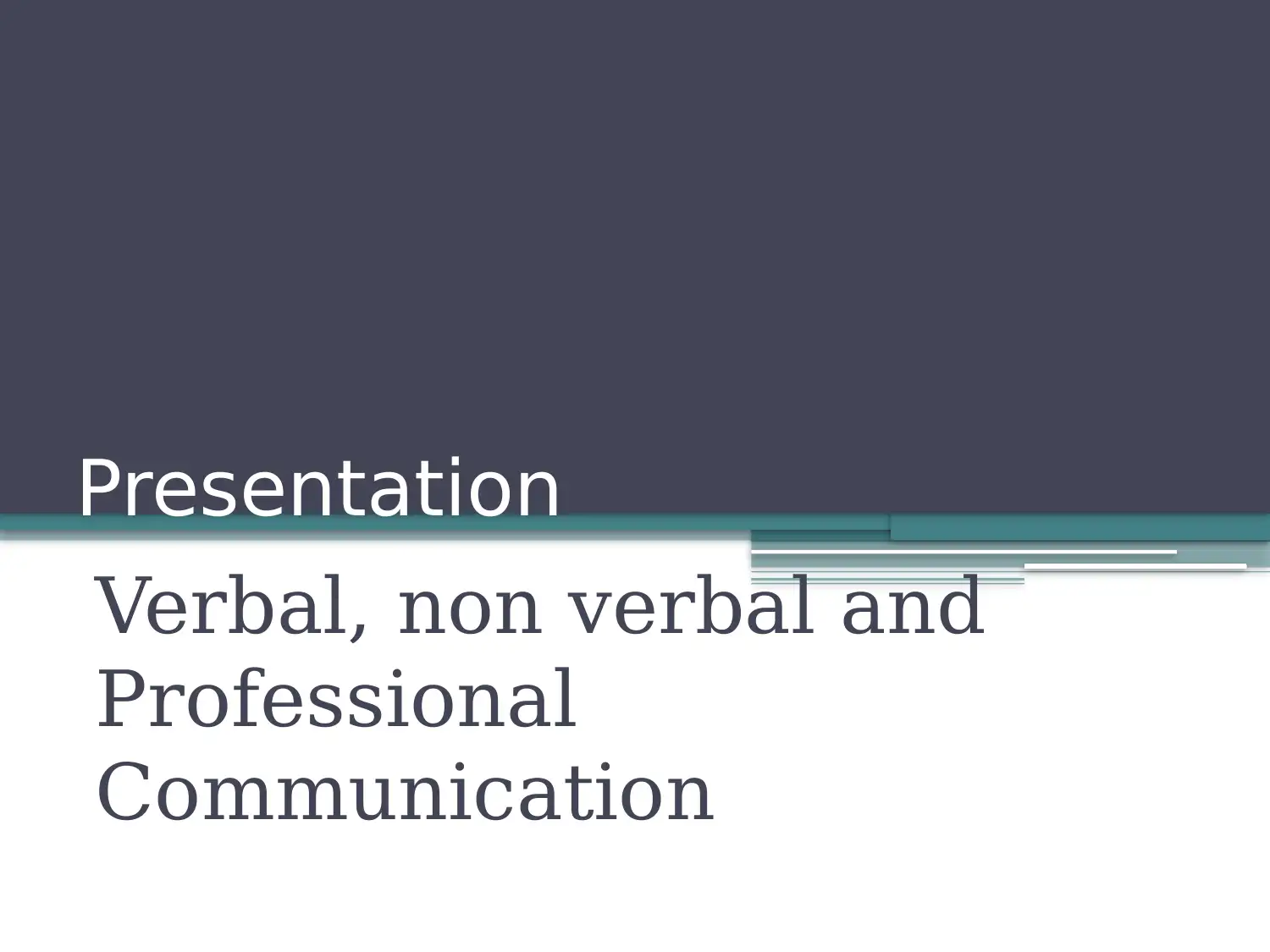
Presentation
Verbal, non verbal and
Professional
Communication
Verbal, non verbal and
Professional
Communication
Secure Best Marks with AI Grader
Need help grading? Try our AI Grader for instant feedback on your assignments.
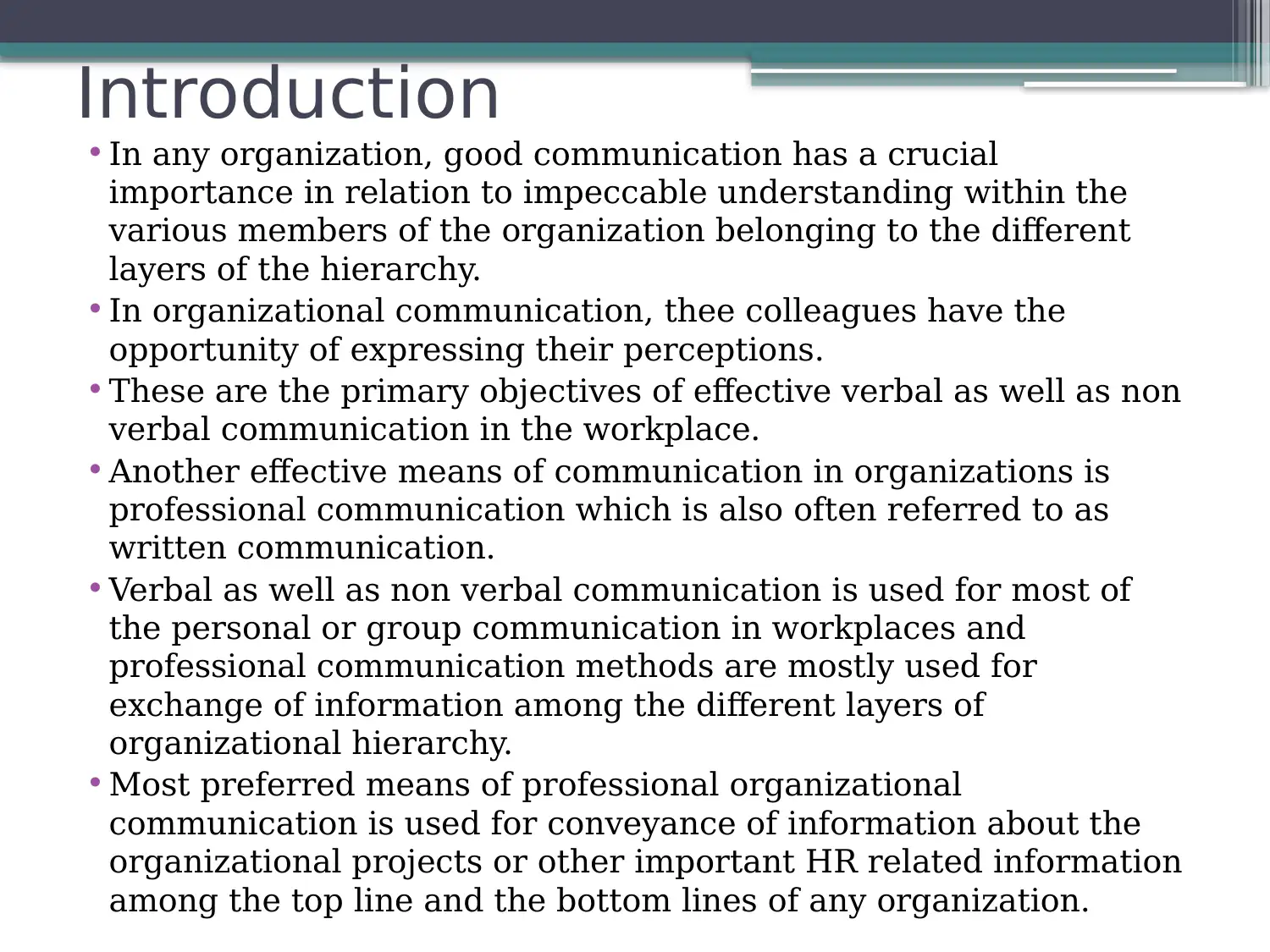
Introduction
• In any organization, good communication has a crucial
importance in relation to impeccable understanding within the
various members of the organization belonging to the different
layers of the hierarchy.
• In organizational communication, thee colleagues have the
opportunity of expressing their perceptions.
• These are the primary objectives of effective verbal as well as non
verbal communication in the workplace.
• Another effective means of communication in organizations is
professional communication which is also often referred to as
written communication.
• Verbal as well as non verbal communication is used for most of
the personal or group communication in workplaces and
professional communication methods are mostly used for
exchange of information among the different layers of
organizational hierarchy.
• Most preferred means of professional organizational
communication is used for conveyance of information about the
organizational projects or other important HR related information
among the top line and the bottom lines of any organization.
• In any organization, good communication has a crucial
importance in relation to impeccable understanding within the
various members of the organization belonging to the different
layers of the hierarchy.
• In organizational communication, thee colleagues have the
opportunity of expressing their perceptions.
• These are the primary objectives of effective verbal as well as non
verbal communication in the workplace.
• Another effective means of communication in organizations is
professional communication which is also often referred to as
written communication.
• Verbal as well as non verbal communication is used for most of
the personal or group communication in workplaces and
professional communication methods are mostly used for
exchange of information among the different layers of
organizational hierarchy.
• Most preferred means of professional organizational
communication is used for conveyance of information about the
organizational projects or other important HR related information
among the top line and the bottom lines of any organization.
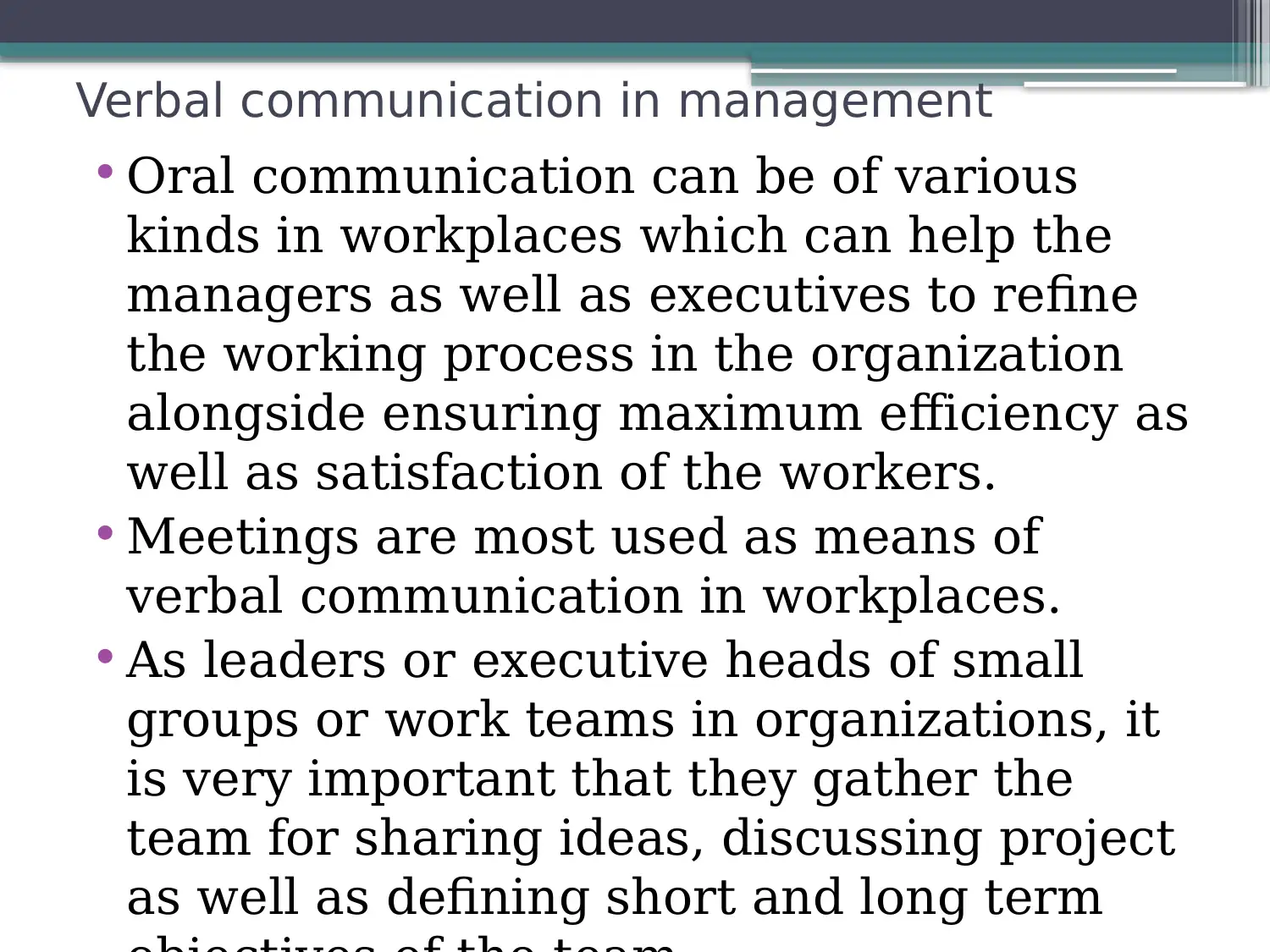
Verbal communication in management
• Oral communication can be of various
kinds in workplaces which can help the
managers as well as executives to refine
the working process in the organization
alongside ensuring maximum efficiency as
well as satisfaction of the workers.
• Meetings are most used as means of
verbal communication in workplaces.
• As leaders or executive heads of small
groups or work teams in organizations, it
is very important that they gather the
team for sharing ideas, discussing project
as well as defining short and long term
• Oral communication can be of various
kinds in workplaces which can help the
managers as well as executives to refine
the working process in the organization
alongside ensuring maximum efficiency as
well as satisfaction of the workers.
• Meetings are most used as means of
verbal communication in workplaces.
• As leaders or executive heads of small
groups or work teams in organizations, it
is very important that they gather the
team for sharing ideas, discussing project
as well as defining short and long term

Verbal communication in management
Continued…
• Another time honored specimen of verbal
communication terms of management in organization
is verbal presentation.
• These presentations are very common in
organizations selling products, particularly at the
time of the product development phase.
• Presentations are developed by professionals having
the power to speak precisely as well as specifically
regarding he aspects of the products or services
offered by the organization (Petronio, 2017).
• Irrespective of the purpose of communication, most
effective examples of verbal presentation include
clear as well as simple language along with usage of
visual aids that can effectively convey the message of
the speakers.
Continued…
• Another time honored specimen of verbal
communication terms of management in organization
is verbal presentation.
• These presentations are very common in
organizations selling products, particularly at the
time of the product development phase.
• Presentations are developed by professionals having
the power to speak precisely as well as specifically
regarding he aspects of the products or services
offered by the organization (Petronio, 2017).
• Irrespective of the purpose of communication, most
effective examples of verbal presentation include
clear as well as simple language along with usage of
visual aids that can effectively convey the message of
the speakers.
Secure Best Marks with AI Grader
Need help grading? Try our AI Grader for instant feedback on your assignments.
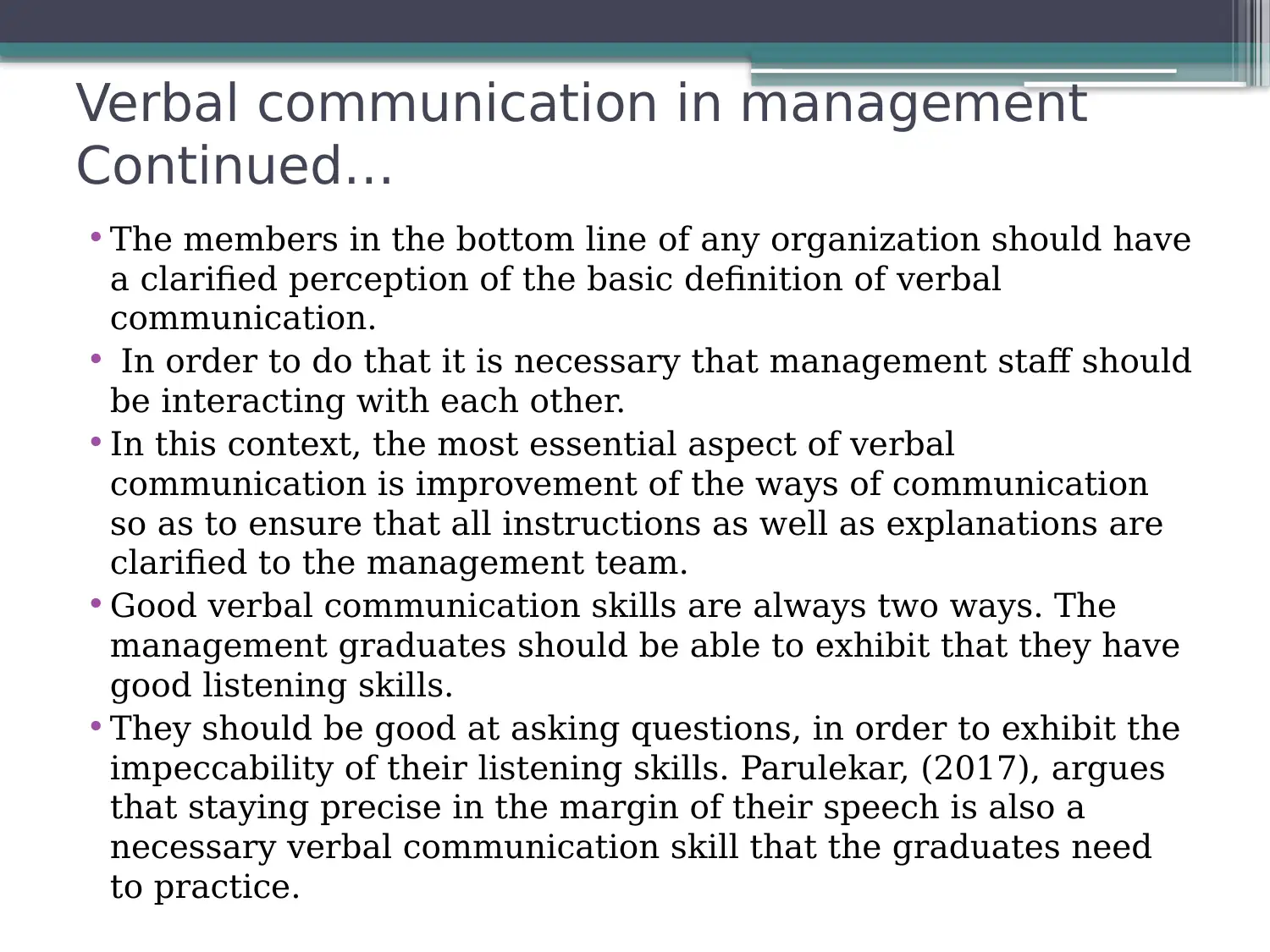
Verbal communication in management
Continued…
• The members in the bottom line of any organization should have
a clarified perception of the basic definition of verbal
communication.
• In order to do that it is necessary that management staff should
be interacting with each other.
• In this context, the most essential aspect of verbal
communication is improvement of the ways of communication
so as to ensure that all instructions as well as explanations are
clarified to the management team.
• Good verbal communication skills are always two ways. The
management graduates should be able to exhibit that they have
good listening skills.
• They should be good at asking questions, in order to exhibit the
impeccability of their listening skills. Parulekar, (2017), argues
that staying precise in the margin of their speech is also a
necessary verbal communication skill that the graduates need
to practice.
Continued…
• The members in the bottom line of any organization should have
a clarified perception of the basic definition of verbal
communication.
• In order to do that it is necessary that management staff should
be interacting with each other.
• In this context, the most essential aspect of verbal
communication is improvement of the ways of communication
so as to ensure that all instructions as well as explanations are
clarified to the management team.
• Good verbal communication skills are always two ways. The
management graduates should be able to exhibit that they have
good listening skills.
• They should be good at asking questions, in order to exhibit the
impeccability of their listening skills. Parulekar, (2017), argues
that staying precise in the margin of their speech is also a
necessary verbal communication skill that the graduates need
to practice.
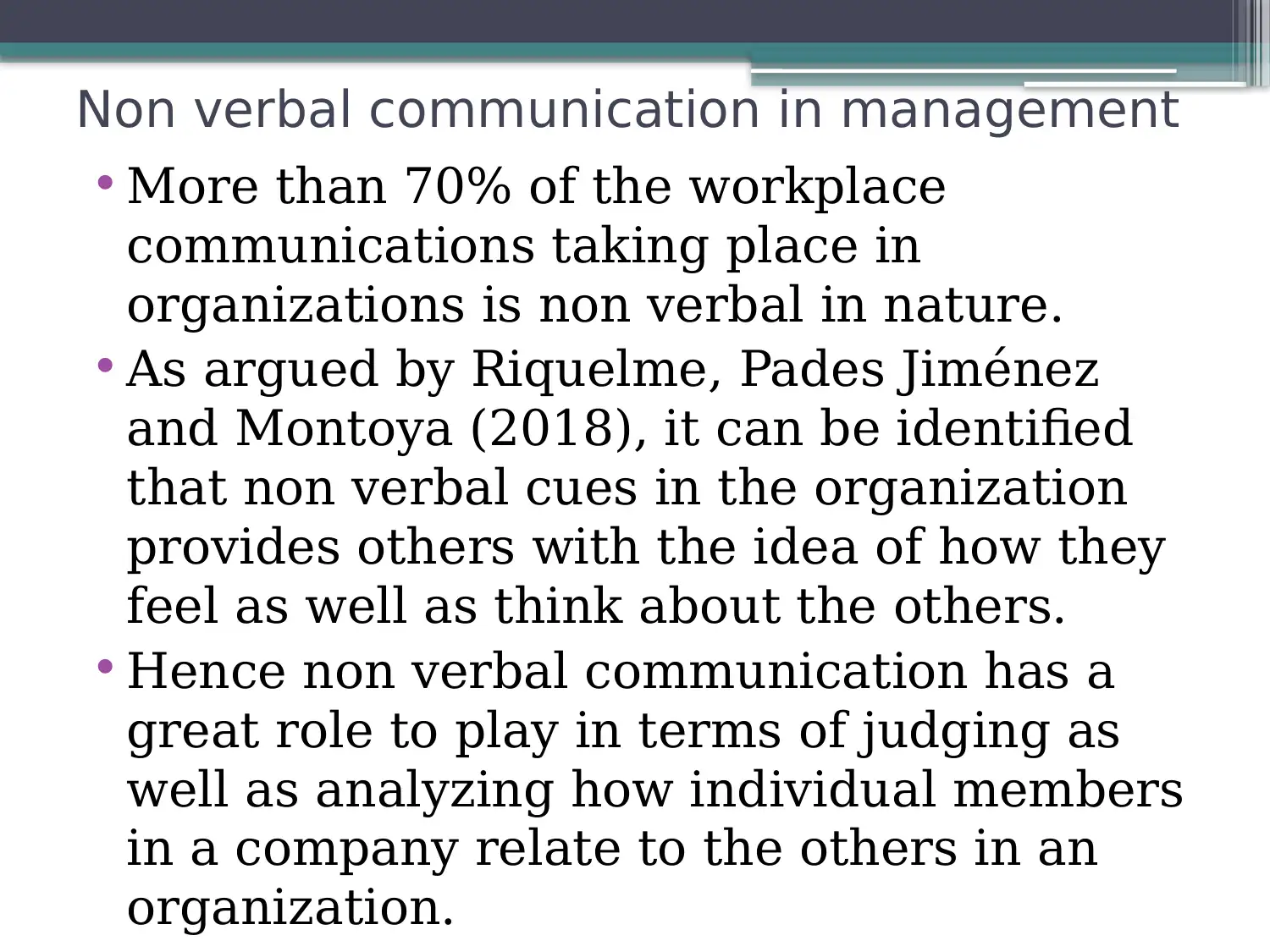
Non verbal communication in management
• More than 70% of the workplace
communications taking place in
organizations is non verbal in nature.
• As argued by Riquelme, Pades Jiménez
and Montoya (2018), it can be identified
that non verbal cues in the organization
provides others with the idea of how they
feel as well as think about the others.
• Hence non verbal communication has a
great role to play in terms of judging as
well as analyzing how individual members
in a company relate to the others in an
organization.
• More than 70% of the workplace
communications taking place in
organizations is non verbal in nature.
• As argued by Riquelme, Pades Jiménez
and Montoya (2018), it can be identified
that non verbal cues in the organization
provides others with the idea of how they
feel as well as think about the others.
• Hence non verbal communication has a
great role to play in terms of judging as
well as analyzing how individual members
in a company relate to the others in an
organization.
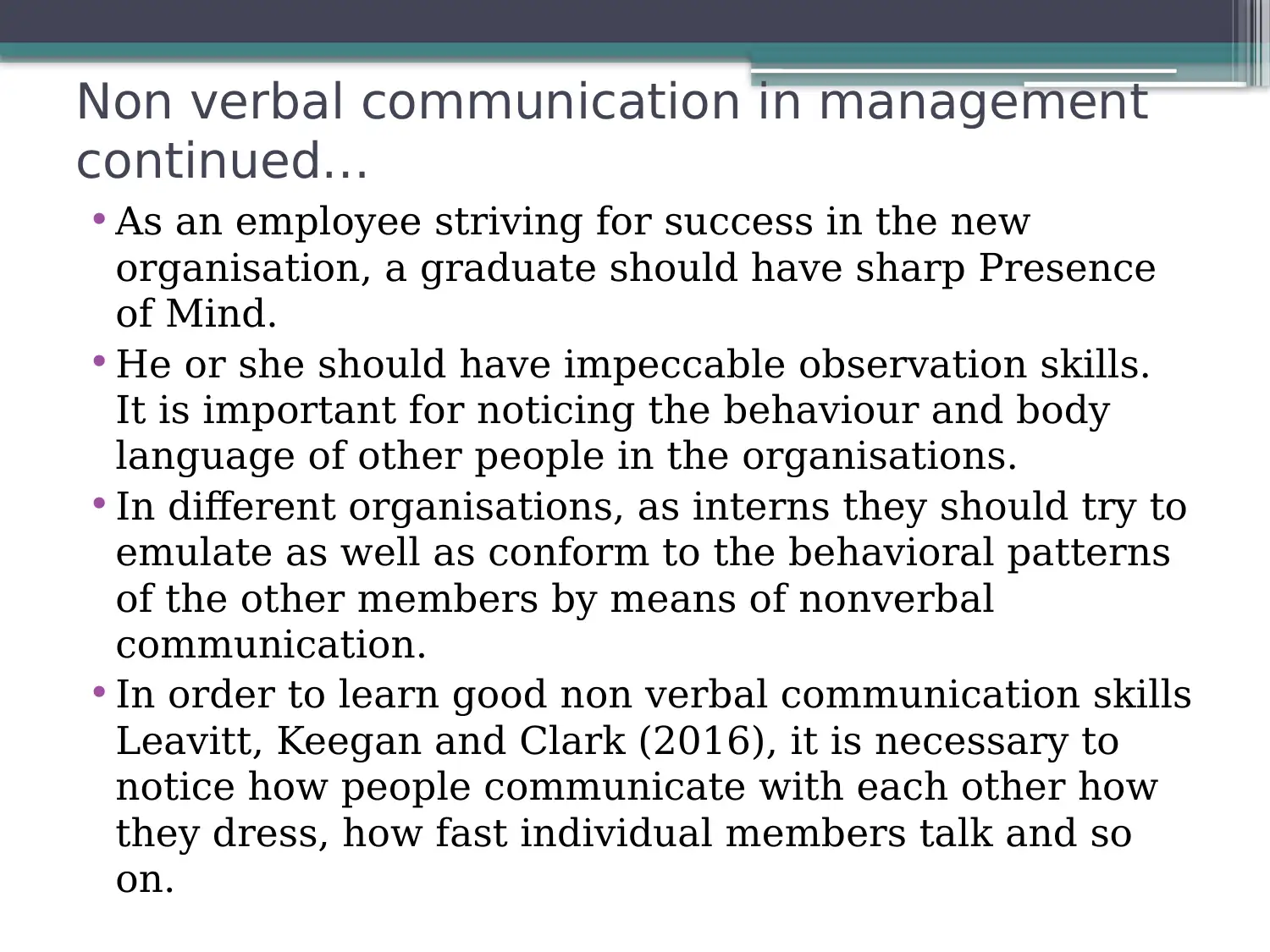
Non verbal communication in management
continued…
• As an employee striving for success in the new
organisation, a graduate should have sharp Presence
of Mind.
• He or she should have impeccable observation skills.
It is important for noticing the behaviour and body
language of other people in the organisations.
• In different organisations, as interns they should try to
emulate as well as conform to the behavioral patterns
of the other members by means of nonverbal
communication.
• In order to learn good non verbal communication skills
Leavitt, Keegan and Clark (2016), it is necessary to
notice how people communicate with each other how
they dress, how fast individual members talk and so
on.
continued…
• As an employee striving for success in the new
organisation, a graduate should have sharp Presence
of Mind.
• He or she should have impeccable observation skills.
It is important for noticing the behaviour and body
language of other people in the organisations.
• In different organisations, as interns they should try to
emulate as well as conform to the behavioral patterns
of the other members by means of nonverbal
communication.
• In order to learn good non verbal communication skills
Leavitt, Keegan and Clark (2016), it is necessary to
notice how people communicate with each other how
they dress, how fast individual members talk and so
on.
Paraphrase This Document
Need a fresh take? Get an instant paraphrase of this document with our AI Paraphraser
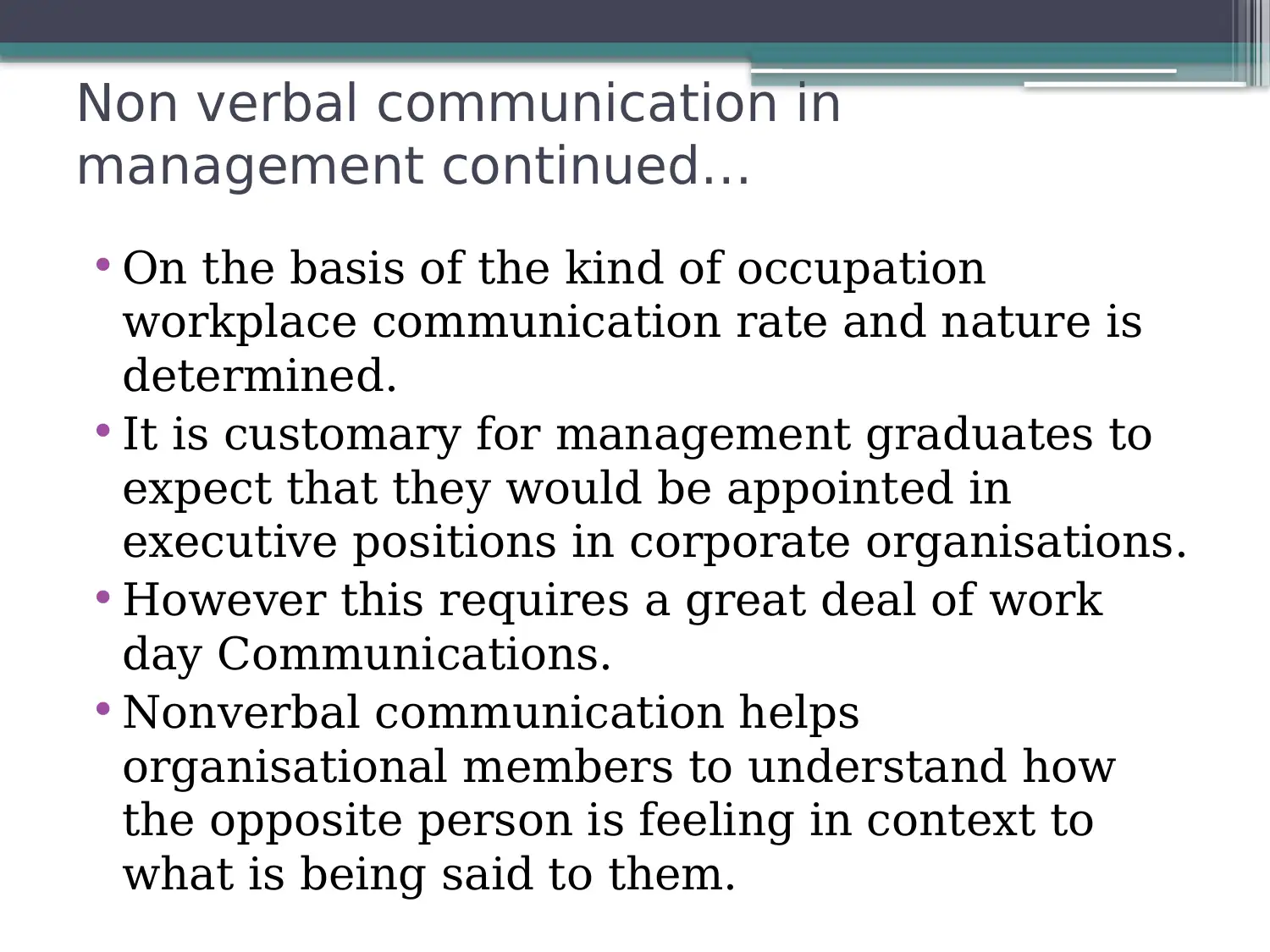
Non verbal communication in
management continued…
• On the basis of the kind of occupation
workplace communication rate and nature is
determined.
• It is customary for management graduates to
expect that they would be appointed in
executive positions in corporate organisations.
• However this requires a great deal of work
day Communications.
• Nonverbal communication helps
organisational members to understand how
the opposite person is feeling in context to
what is being said to them.
management continued…
• On the basis of the kind of occupation
workplace communication rate and nature is
determined.
• It is customary for management graduates to
expect that they would be appointed in
executive positions in corporate organisations.
• However this requires a great deal of work
day Communications.
• Nonverbal communication helps
organisational members to understand how
the opposite person is feeling in context to
what is being said to them.
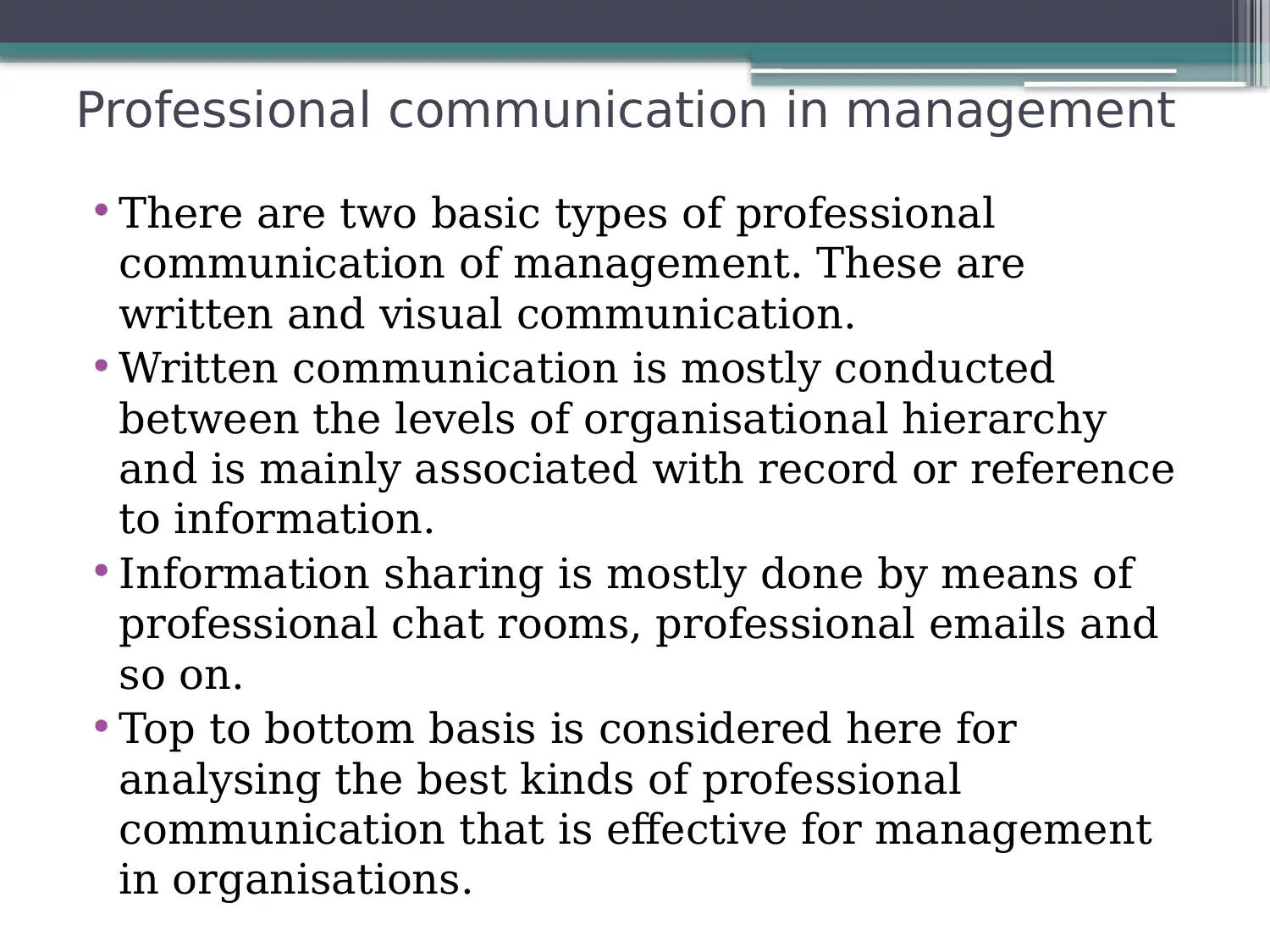
Professional communication in management
• There are two basic types of professional
communication of management. These are
written and visual communication.
• Written communication is mostly conducted
between the levels of organisational hierarchy
and is mainly associated with record or reference
to information.
• Information sharing is mostly done by means of
professional chat rooms, professional emails and
so on.
• Top to bottom basis is considered here for
analysing the best kinds of professional
communication that is effective for management
in organisations.
• There are two basic types of professional
communication of management. These are
written and visual communication.
• Written communication is mostly conducted
between the levels of organisational hierarchy
and is mainly associated with record or reference
to information.
• Information sharing is mostly done by means of
professional chat rooms, professional emails and
so on.
• Top to bottom basis is considered here for
analysing the best kinds of professional
communication that is effective for management
in organisations.

Professional communication in
management Continued…
• One of the most important benefits of written
communication for professional medium is that the sender
of the message always has the time to review the text
which is to be used for communication.
• The most common forms of messages that needs to be
reviewed are emails, letters as well as memos.
• Reviewing the messages not only provides opportunity to
identify mistakes as well as creates opportunity to say
something in a different way.
• In this context important Communications or those
messages which targets large number of people needs to
be viewed as well as reviewed by the person who has
written it as well as others (Upadhyay, 2019).
• People should review it in order to defeat any perceptive
flaws or critical references that might have been missed
by the sender of the message.
management Continued…
• One of the most important benefits of written
communication for professional medium is that the sender
of the message always has the time to review the text
which is to be used for communication.
• The most common forms of messages that needs to be
reviewed are emails, letters as well as memos.
• Reviewing the messages not only provides opportunity to
identify mistakes as well as creates opportunity to say
something in a different way.
• In this context important Communications or those
messages which targets large number of people needs to
be viewed as well as reviewed by the person who has
written it as well as others (Upadhyay, 2019).
• People should review it in order to defeat any perceptive
flaws or critical references that might have been missed
by the sender of the message.
Secure Best Marks with AI Grader
Need help grading? Try our AI Grader for instant feedback on your assignments.
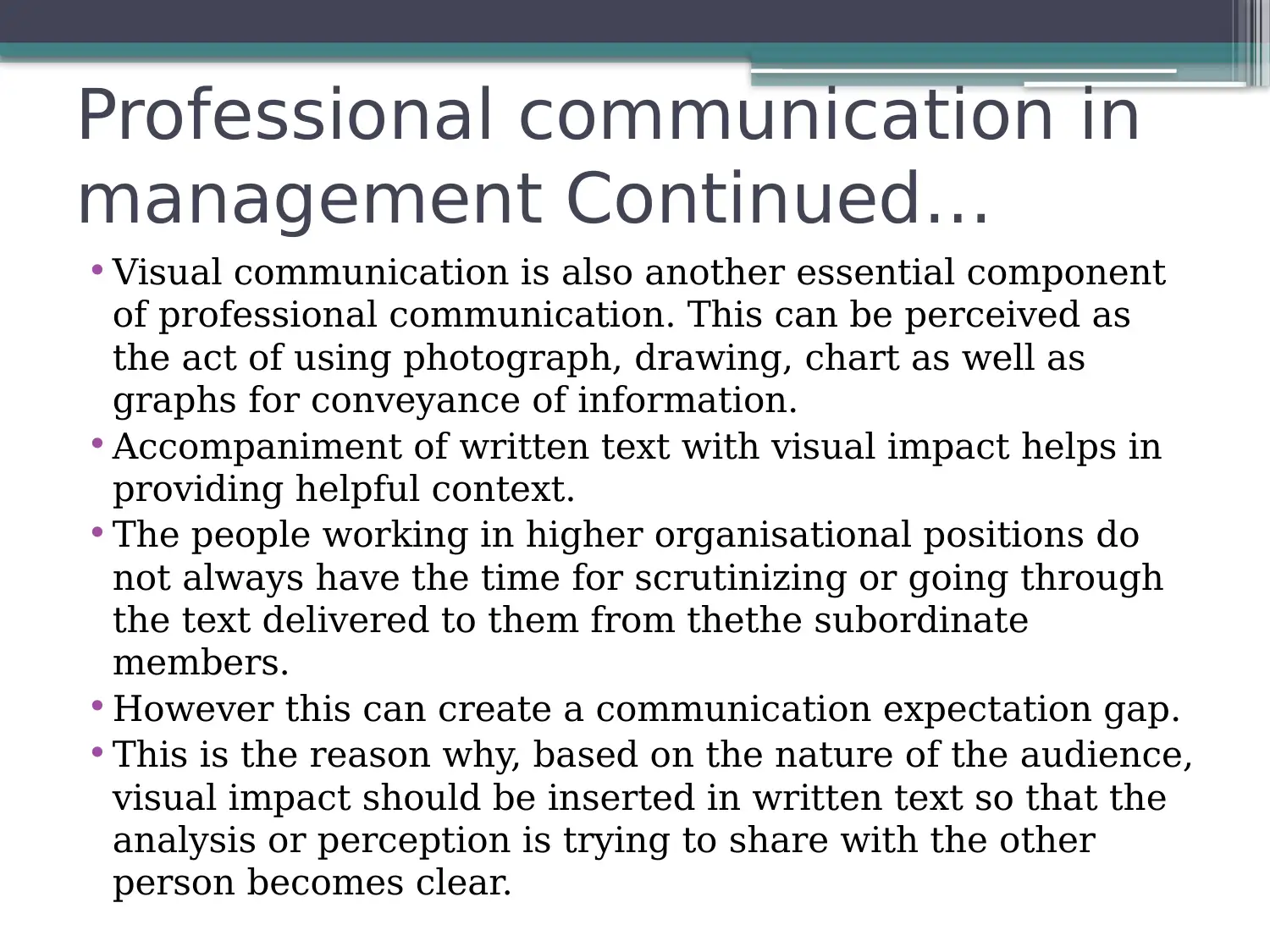
Professional communication in
management Continued…
• Visual communication is also another essential component
of professional communication. This can be perceived as
the act of using photograph, drawing, chart as well as
graphs for conveyance of information.
• Accompaniment of written text with visual impact helps in
providing helpful context.
• The people working in higher organisational positions do
not always have the time for scrutinizing or going through
the text delivered to them from thethe subordinate
members.
• However this can create a communication expectation gap.
• This is the reason why, based on the nature of the audience,
visual impact should be inserted in written text so that the
analysis or perception is trying to share with the other
person becomes clear.
management Continued…
• Visual communication is also another essential component
of professional communication. This can be perceived as
the act of using photograph, drawing, chart as well as
graphs for conveyance of information.
• Accompaniment of written text with visual impact helps in
providing helpful context.
• The people working in higher organisational positions do
not always have the time for scrutinizing or going through
the text delivered to them from thethe subordinate
members.
• However this can create a communication expectation gap.
• This is the reason why, based on the nature of the audience,
visual impact should be inserted in written text so that the
analysis or perception is trying to share with the other
person becomes clear.
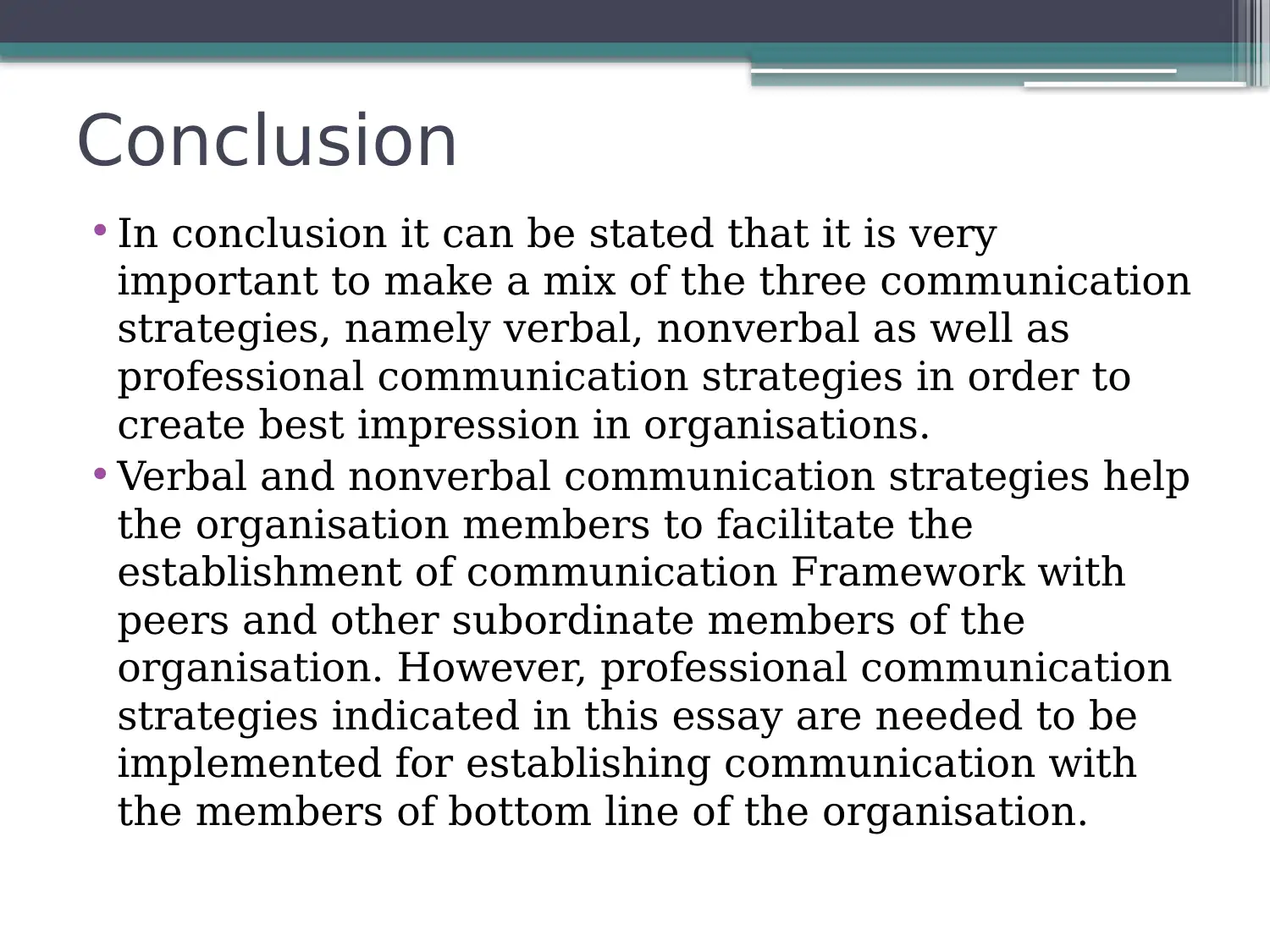
Conclusion
• In conclusion it can be stated that it is very
important to make a mix of the three communication
strategies, namely verbal, nonverbal as well as
professional communication strategies in order to
create best impression in organisations.
• Verbal and nonverbal communication strategies help
the organisation members to facilitate the
establishment of communication Framework with
peers and other subordinate members of the
organisation. However, professional communication
strategies indicated in this essay are needed to be
implemented for establishing communication with
the members of bottom line of the organisation.
• In conclusion it can be stated that it is very
important to make a mix of the three communication
strategies, namely verbal, nonverbal as well as
professional communication strategies in order to
create best impression in organisations.
• Verbal and nonverbal communication strategies help
the organisation members to facilitate the
establishment of communication Framework with
peers and other subordinate members of the
organisation. However, professional communication
strategies indicated in this essay are needed to be
implemented for establishing communication with
the members of bottom line of the organisation.

References
• Verbal communication
• 1.Rozenfeld, R. A., Nannicelli, A. P., Brown, A. R., Eppich, W. J., Woods, D.
M., Lestrud, S. O., ... &Holl, J. L. (2016). Verbal Communication During
Airway Management and Emergent Endotracheal Intubation: Observations
of Team Behavior Among Multi-institutional Pediatric Intensive Care Unit
In Situ Simulations. Journal of patient safety.
• 2.Petronio, S. (2017). Communication privacy management theory:
Understanding families. In Engaging theories in family communication (pp.
87-97). Routledge.
• 3.Grenness, C., Hickson, L., Laplante-Lévesque, A., Meyer, C., & Davidson,
B. (2015). The nature of communication throughout diagnosis and
management planning in initial audiologic rehabilitation
consultations. Journal of the American Academy of Audiology, 26(1), 36-50.
• 4.Parulekar, M. S. (2017). NON VERBAL COMMUNICATION A TOOL FOR
EFFECTIVE CORPORATE TRAINING WITH SPECIAL REFERENCE TO
MUMBAI.
• Garcia, F. (2019). School Managers’ Verbal Communication Skills and
Conflict Resolution Strategies: Basis for Developing an Action Plan to
Enhance Managers’ Skills. IOER International Multidisciplinary Research
Journal, 1(2), 20-29.
• Verbal communication
• 1.Rozenfeld, R. A., Nannicelli, A. P., Brown, A. R., Eppich, W. J., Woods, D.
M., Lestrud, S. O., ... &Holl, J. L. (2016). Verbal Communication During
Airway Management and Emergent Endotracheal Intubation: Observations
of Team Behavior Among Multi-institutional Pediatric Intensive Care Unit
In Situ Simulations. Journal of patient safety.
• 2.Petronio, S. (2017). Communication privacy management theory:
Understanding families. In Engaging theories in family communication (pp.
87-97). Routledge.
• 3.Grenness, C., Hickson, L., Laplante-Lévesque, A., Meyer, C., & Davidson,
B. (2015). The nature of communication throughout diagnosis and
management planning in initial audiologic rehabilitation
consultations. Journal of the American Academy of Audiology, 26(1), 36-50.
• 4.Parulekar, M. S. (2017). NON VERBAL COMMUNICATION A TOOL FOR
EFFECTIVE CORPORATE TRAINING WITH SPECIAL REFERENCE TO
MUMBAI.
• Garcia, F. (2019). School Managers’ Verbal Communication Skills and
Conflict Resolution Strategies: Basis for Developing an Action Plan to
Enhance Managers’ Skills. IOER International Multidisciplinary Research
Journal, 1(2), 20-29.
Paraphrase This Document
Need a fresh take? Get an instant paraphrase of this document with our AI Paraphraser
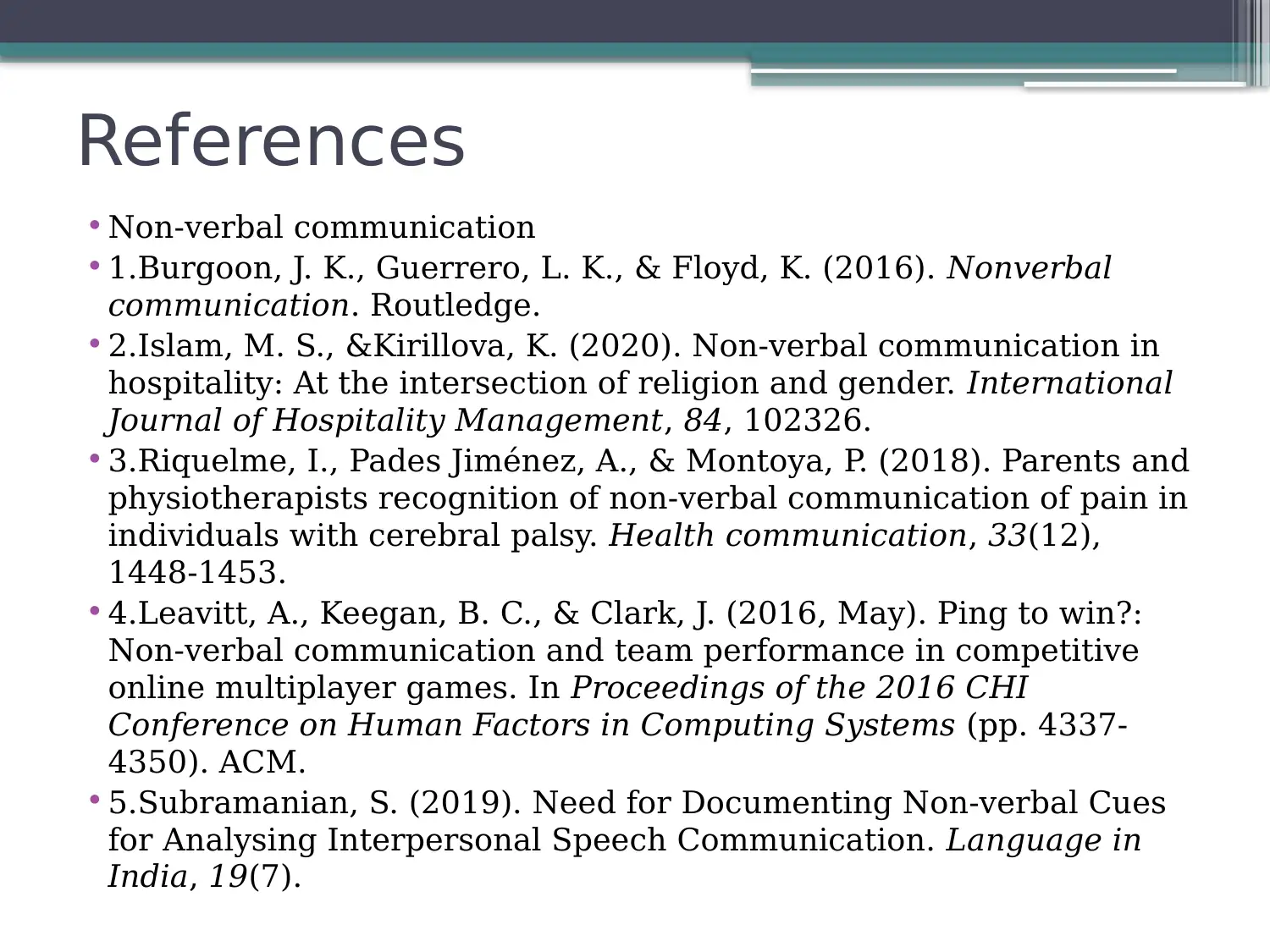
References
• Non-verbal communication
• 1.Burgoon, J. K., Guerrero, L. K., & Floyd, K. (2016). Nonverbal
communication. Routledge.
• 2.Islam, M. S., &Kirillova, K. (2020). Non-verbal communication in
hospitality: At the intersection of religion and gender. International
Journal of Hospitality Management, 84, 102326.
• 3.Riquelme, I., Pades Jiménez, A., & Montoya, P. (2018). Parents and
physiotherapists recognition of non-verbal communication of pain in
individuals with cerebral palsy. Health communication, 33(12),
1448-1453.
• 4.Leavitt, A., Keegan, B. C., & Clark, J. (2016, May). Ping to win?:
Non-verbal communication and team performance in competitive
online multiplayer games. In Proceedings of the 2016 CHI
Conference on Human Factors in Computing Systems (pp. 4337-
4350). ACM.
• 5.Subramanian, S. (2019). Need for Documenting Non-verbal Cues
for Analysing Interpersonal Speech Communication. Language in
India, 19(7).
• Non-verbal communication
• 1.Burgoon, J. K., Guerrero, L. K., & Floyd, K. (2016). Nonverbal
communication. Routledge.
• 2.Islam, M. S., &Kirillova, K. (2020). Non-verbal communication in
hospitality: At the intersection of religion and gender. International
Journal of Hospitality Management, 84, 102326.
• 3.Riquelme, I., Pades Jiménez, A., & Montoya, P. (2018). Parents and
physiotherapists recognition of non-verbal communication of pain in
individuals with cerebral palsy. Health communication, 33(12),
1448-1453.
• 4.Leavitt, A., Keegan, B. C., & Clark, J. (2016, May). Ping to win?:
Non-verbal communication and team performance in competitive
online multiplayer games. In Proceedings of the 2016 CHI
Conference on Human Factors in Computing Systems (pp. 4337-
4350). ACM.
• 5.Subramanian, S. (2019). Need for Documenting Non-verbal Cues
for Analysing Interpersonal Speech Communication. Language in
India, 19(7).
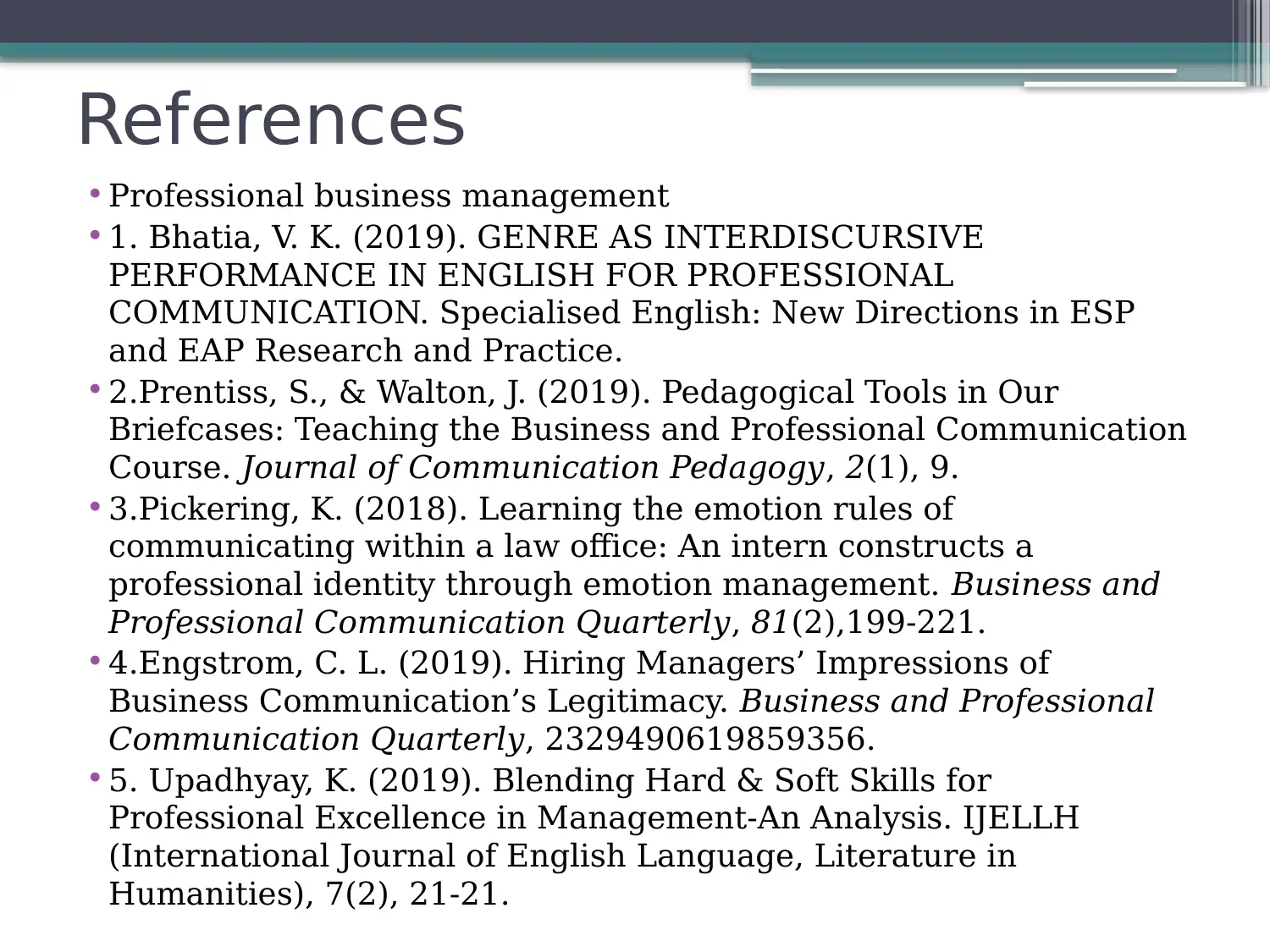
References
• Professional business management
• 1. Bhatia, V. K. (2019). GENRE AS INTERDISCURSIVE
PERFORMANCE IN ENGLISH FOR PROFESSIONAL
COMMUNICATION. Specialised English: New Directions in ESP
and EAP Research and Practice.
• 2.Prentiss, S., & Walton, J. (2019). Pedagogical Tools in Our
Briefcases: Teaching the Business and Professional Communication
Course. Journal of Communication Pedagogy, 2(1), 9.
• 3.Pickering, K. (2018). Learning the emotion rules of
communicating within a law office: An intern constructs a
professional identity through emotion management. Business and
Professional Communication Quarterly, 81(2),199-221.
• 4.Engstrom, C. L. (2019). Hiring Managers’ Impressions of
Business Communication’s Legitimacy. Business and Professional
Communication Quarterly, 2329490619859356.
• 5. Upadhyay, K. (2019). Blending Hard & Soft Skills for
Professional Excellence in Management-An Analysis. IJELLH
(International Journal of English Language, Literature in
Humanities), 7(2), 21-21.
• Professional business management
• 1. Bhatia, V. K. (2019). GENRE AS INTERDISCURSIVE
PERFORMANCE IN ENGLISH FOR PROFESSIONAL
COMMUNICATION. Specialised English: New Directions in ESP
and EAP Research and Practice.
• 2.Prentiss, S., & Walton, J. (2019). Pedagogical Tools in Our
Briefcases: Teaching the Business and Professional Communication
Course. Journal of Communication Pedagogy, 2(1), 9.
• 3.Pickering, K. (2018). Learning the emotion rules of
communicating within a law office: An intern constructs a
professional identity through emotion management. Business and
Professional Communication Quarterly, 81(2),199-221.
• 4.Engstrom, C. L. (2019). Hiring Managers’ Impressions of
Business Communication’s Legitimacy. Business and Professional
Communication Quarterly, 2329490619859356.
• 5. Upadhyay, K. (2019). Blending Hard & Soft Skills for
Professional Excellence in Management-An Analysis. IJELLH
(International Journal of English Language, Literature in
Humanities), 7(2), 21-21.

1 out of 16
Related Documents
Your All-in-One AI-Powered Toolkit for Academic Success.
+13062052269
info@desklib.com
Available 24*7 on WhatsApp / Email
![[object Object]](/_next/static/media/star-bottom.7253800d.svg)
Unlock your academic potential
© 2024 | Zucol Services PVT LTD | All rights reserved.




